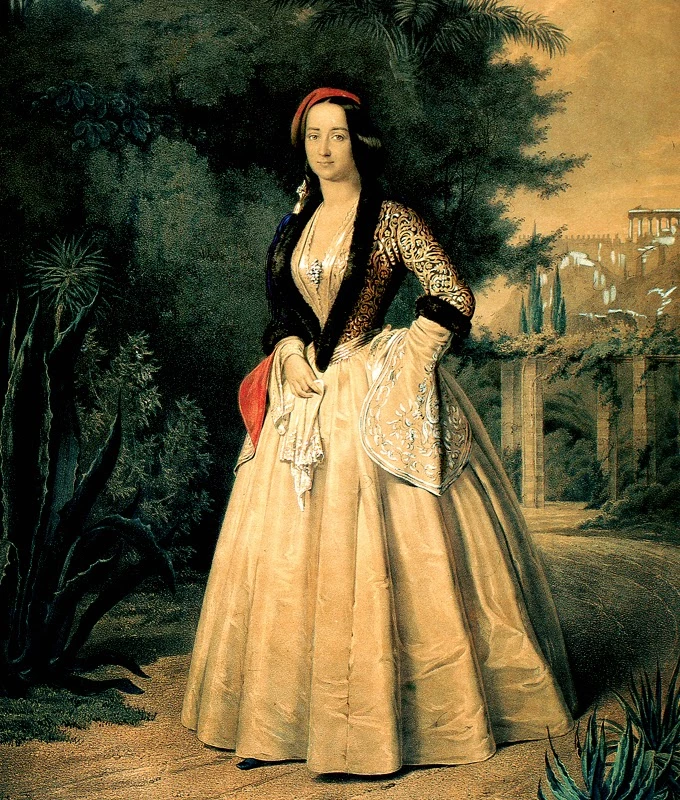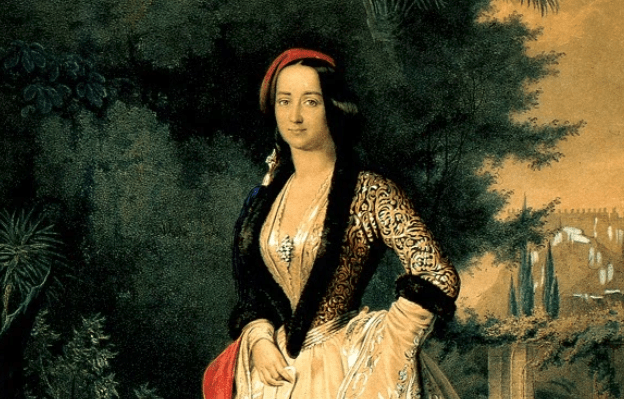As we continue to celebrate the bicentenary of the 1821 War of Independence, the prelude to recognition of a sovereign Greek state in 1830, it is only just and fair to remember Amalia, the spouse of the country's first elected king. Born in Oldenburg in 1818, she arrived in Piraeus in the spring of 1837 on the arm of King Otto, a young, beautiful, well educated and lively bride, eager to explore her new homeland, hoping to be accepted by its "oddly-garbed" citizens.
While Otto, who Hellenized his name to Othon, followed the advice of his father, Ludwig I of Bavaria, and stepped off the warship bearing the royal couple dressed in the foustanélla, the pleated kilt associated with the liberation fighters, however, no such advice was forthcoming for his consort – nor did any stylized female attire typical to this fledgling nation exist for her to adopt.
Queen Amalia therefore came ashore wearing a fashionable white silk dress and a huge picture hat, also white. Little did the dazzled onlookers know that this would be a defining moment in the emergence of a sense of Greek nationhood!

At the time of Otto's ascension to the throne, Greece comprised only the Morea (Peloponnese), Continental Greece and the Cyclades, its northern border with the Ottoman Empire running along the Arta-Volos line, while her population included people of Greek descent from many different countries, each with their own sartorial habits and styles (as can be seen, for example, in Louis Dupré's 1825 hand-painted lithograph of the "Athenian Bride," who is attended by people all dressed in different styles).
Establishing a national identity was thus a matter of vital importance as the country's sovereignty, and hence its viability, depended on developing a collective ideology allowing the members of this heterogeneous human mosaic to acknowledge one another as belonging to the same nation and sharing the same culture. Dress would become one such unifying element, and in this respect, Amalia's sense of fashion and the creation of a dress code now known as the "Amalia costume" (stolí Amalías) would be of prime importance.
If Otto contributed to establishing Greek national identity by adopting the foustanélla as formal garb, thus developing its visual image while transforming it into a form of urban dress, Amalia was obliged to devise the female equivalent and oversee its adoption. Although it remains unknown as to who guided her to create a dress style inspired by both Western European fashion and Greek traditional costume, it is accepted that, right from the start, the royal couple consciously paid tribute to the heroes of the Greek Revolution by choosing attire reminiscent of Greece's recent past.
Thus, after initially requesting her Greek ladies-in-waiting, most of whom were the relatives of freedom fighters, to wear the traditional costume of their respective places of origin, Amalia went a step further and introduced a fabricated ensemble combining elements from her subjects' Oriental past to that of her own European origin.
The presence in the royal palace of local costumes from island and mainland Greece can be seen as an attempt to symbolise the political unity of the recently liberated areas now forming the fledgling Kingdom of Greece, while the adoption of the "Amalia costume" brings about the uniformity of a nation-in-the-making at the same time as signifying a transition from the Eastern to the Western world and from tradition to modernity.

The costume itself consisted of a long dress, the foustáni or kavádi, sharply reminiscent of the Biedermeier style popular in nineteenth century Germany and Austria, with a low-necked, close-fitting bodice inspired by the traditional Greek kavádi (a type of long-sleeved dress) that was left open to show a lavishly-embroidered chemise front and long sleeves. Over this, a short, close-fitting gold-embroidered velvet jacket, the kondogoúni or zipoúni, was worn. The ensemble was completed by a red féssi, a cap with a long tassel made of braided gold threads and adorned with pearls or sequins worn at an angle and held in place by a gold- or pearl-embroidered band secured under the chin and which was covered with a black mantilla when going to church.
The dress was made of precious raw fabrics, silk taffeta with woven floral motifs, silk moiré or costly brocade, often interwoven with gold thread, and consisted of a double skirt with ruffles or of a long skirt with rich folds at the waistline. It is first mentioned in detail in letters the young queen sent to her father in October 1839.

Contrary to the foustanélla, the "Amalia costume" today no longer functions as a visible symbol of the Greek nation. For contemporary Greeks, the foustanélla remains directly linked to the Greek Revolution and the nation's identity, possibly because it is part of the Presidential Guard's uniform, whereas the "Amalia costume" has lost much of its symbolic content and is now relegated to the attire of parading school children on national holidays or fancy dress outfits at carnival.
Though fashion generally originates in the upper reaches of society before passing on to the middle classes, and from there to the lower social strata, it sometimes also moves "up" from the masses, influencing the upper class style, especially when it comes to the incorporation of ethnic or folklore elements. The "Amalia costume" worked in both directions, blending the embroidered bodices of local costumes' festive version with the Biedermeier-style dress, setting a trend that rippled out into society.
Indeed, by defining a dress code imperatively worn by her ladies-in-waiting, adopted by the dignitaries' womenfolk, imitated by the urban merchant class and then taken up in rural areas as distant as Samos, which was still under Ottoman rule, Amalia effectively established a standard sartorial outfit directly associated with Greek nationality that also reflected the people's need for a unifying symbol - a constructed set of garments corresponding to the particular historical, economic, social and political circumstances of its creation.
---
ARTWORK: Nikiforos Lytras | Franz Hanfstaengl
Nadia Macha-Bizoumi is Assistant Professor of Folklore at Democritus University of Thrace. She is a founder member and deputy chairwoman of the Hellenic Costume Society, and a member of the International Council of Museums (ICOM GR), of the ICOM Costume Committee (ICC), and of the Greek Folklore Society.


